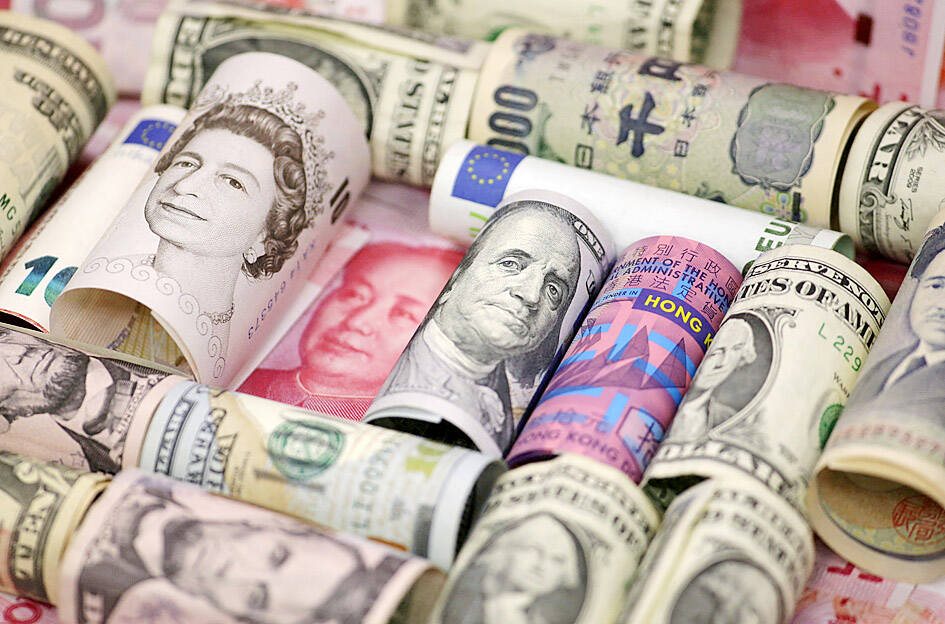The nation’s foreign exchange reserves last month shed US$1.3 billion to US$576.677 billion due to a flight of capital, but managed to gain US$6.03 billion for the whole of last year, helped by strong exports, the central bank said yesterday.
The results came after foreign portfolio managers cut net holdings in local shares by more than US$30 billion, contributing to the New Taiwan dollar’s annual 6.42 percent decline against the greenback, Department of Foreign Exchange Director-General Eugene Tsai (蔡炯民) said.
The New Taiwan dollar weakened 0.75 percent against the US dollar last month, relatively stable compared with the Chinese yuan’s 1.09 percent decrease, the euro’s 1.56 percent retreat, the British pound’s 1.28 percent drop and the yen’s 4.05 percent plunge, Tsai said.

Photo: Reuters
Taiwan’s exports have benefited from the boom in artificial intelligence and lent support to the NT dollar, Tsai said, admitting that the central bank intervened several times to slow the local currency’s depreciation in the second half of last year.
Global capital flows to US dollar-denominated assets gained speed in the final quarter of last year after the US economy proved resilient, driving the Federal Reserve to raise its GDP growth and inflation forecasts last month.
US president-elect Donald Trump’s tariff threats on imports also fueled inflation outlook adjustments, Tsai said, adding that financial markets are now looking at only two interest rate cuts by the Fed this year, from four previously.
“The change spurred global fund redeployments,” Tsai said, as global money is in constant pursuit of investments with better returns.
Taiwan remains the world’s fourth-largest holder of foreign exchange reserves after China, Japan and Switzerland, he said.
In related news, the Financial Supervisory Commission yesterday said that foreign institutional investors recorded a net fund inflow of US$5.68 billion last month, reversing a net fund outflow of US$1.297 billion in November.
Foreign institutional investors registered a net fund inflow of US$37.196 billion last year, the highest level since the commission began tallying such flows in 2011.
Last year's figure eclipsed the US$29.478 billion in net fund inflows in 2023, as the TAIEX soared 28.47 percent, the commission said.
With foreign institutional investors investing heavily in big AI-related names last year, the combined market capitalization of chipmaker Taiwan Semiconductor Manufacturing Co (台積電), smartphone IC designer MediaTek Inc (聯發科) and IC packaging and testing services provider ASE Technology Holding Co (日月光投控) rose by more than NT$13 trillion, the commission said.
As a result, foreign institutional investors owned 43.09 percent of the main exchange and over-the-counter (OTC) market at the end of last year, when total market capitalization hit NT$80.40 trillion (US$2.5 trillion), it said.
The 43.09 percent was up from the 38.47 percent seen at the end of 2023, the commission said.
Despite foreign institutional investors' high level of holdings in the market and net fund inflows, they were actually net sellers of NT$682.57 billion (US$21.26 billion) in shares on the main exchange and OTC market, the commission said.
Analysts said the numbers indicated that many foreign institutional investors were keeping funds in Taiwan after cashing out some of their stock holdings, looking for other investment opportunities in the local market.

The New Taiwan dollar is on the verge of overtaking the yuan as Asia’s best carry-trade target given its lower risk of interest-rate and currency volatility. A strategy of borrowing the New Taiwan dollar to invest in higher-yielding alternatives has generated the second-highest return over the past month among Asian currencies behind the yuan, based on the Sharpe ratio that measures risk-adjusted relative returns. The New Taiwan dollar may soon replace its Chinese peer as the region’s favored carry trade tool, analysts say, citing Beijing’s efforts to support the yuan that can create wild swings in borrowing costs. In contrast,

Nvidia Corp’s demand for advanced packaging from Taiwan Semiconductor Manufacturing Co (TSMC, 台積電) remains strong though the kind of technology it needs is changing, Nvidia CEO Jensen Huang (黃仁勳) said yesterday, after he was asked whether the company was cutting orders. Nvidia’s most advanced artificial intelligence (AI) chip, Blackwell, consists of multiple chips glued together using a complex chip-on-wafer-on-substrate (CoWoS) advanced packaging technology offered by TSMC, Nvidia’s main contract chipmaker. “As we move into Blackwell, we will use largely CoWoS-L. Of course, we’re still manufacturing Hopper, and Hopper will use CowoS-S. We will also transition the CoWoS-S capacity to CoWos-L,” Huang said

VERTICAL INTEGRATION: The US fabless company’s acquisition of the data center manufacturer would not affect market competition, the Fair Trade Commission said The Fair Trade Commission has approved Advanced Micro Devices Inc’s (AMD) bid to fully acquire ZT International Group Inc for US$4.9 billion, saying it would not hamper market competition. As AMD is a fabless company that designs central processing units (CPUs) used in consumer electronics and servers, while ZT is a data center manufacturer, the vertical integration would not affect market competition, the commission said in a statement yesterday. ZT counts hyperscalers such as Microsoft Corp, Amazon.com Inc and Google among its major clients and plays a minor role in deciding the specifications of data centers, given the strong bargaining power of

Nvidia Corp CEO Jensen Huang (黃仁勳) is expected to miss the inauguration of US president-elect Donald Trump on Monday, bucking a trend among high-profile US technology leaders. Huang is visiting East Asia this week, as he typically does around the time of the Lunar New Year, a person familiar with the situation said. He has never previously attended a US presidential inauguration, said the person, who asked not to be identified, because the plans have not been announced. That makes Nvidia an exception among the most valuable technology companies, most of which are sending cofounders or CEOs to the event. That includes